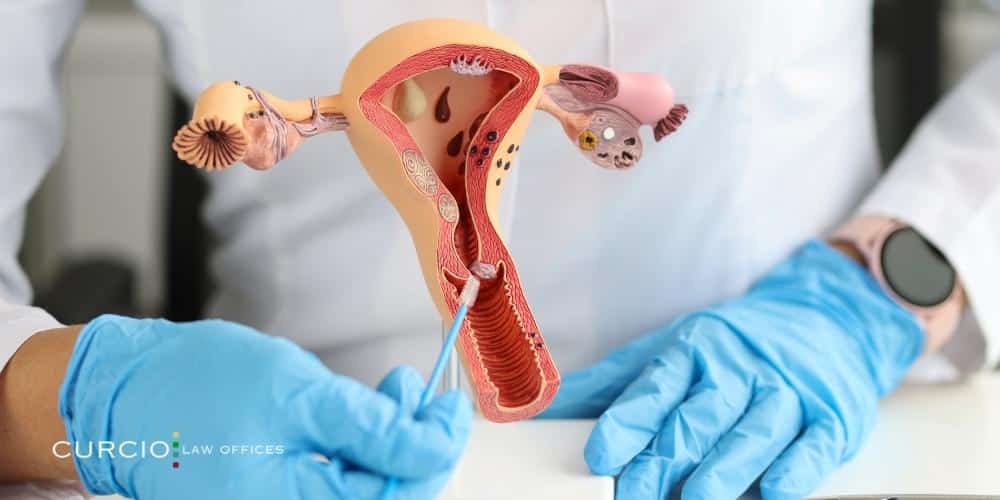A hysterectomy is a life-altering surgical procedure that’s often used as a last resort for major medical conditions. Not only does a hysterectomy often trigger surgical menopause for many women, but it also completely prevents the possibility of future pregnancies. That’s why an unnecessary or botched hysterectomy is so physically and emotionally traumatic for women. Women who suffer from this type of medical negligence may have grounds to file an unnecessary hysterectomy lawsuit.
You can trust the experienced legal professionals at Curcio & Casciato with any type of medical malpractice claim. We know how physically, emotionally, and financially devastating medical negligence is for victims. That’s why the attorneys at our Chicago law firm are so passionate about pursuing justice for the injured party. Call us today at 312-321-1111 to schedule a free consultation.
What is a Hysterectomy?
A hysterectomy is a surgical procedure in which a doctor removes a woman’s uterus from her body.
When is a Hysterectomy Necessary?
Women may undergo a hysterectomy procedure for a variety of medical conditions, including:
- Chronic pain and irregular bleeding from uterine fibroids
- Cervical, uterine, or ovarian cancer
- Uterine prolapse which is when the uterus slides into the vaginal canal
- Endometriosis, adenomyosis, and heavy vaginal bleeding
- Pregnancy prevention
While a hysterectomy is an effective treatment for many types of medical conditions, doctors will only recommend it for noncancerous conditions when all other treatment options have been exhausted and unsuccessful. That’s because a hysterectomy is obviously permanent, leaving women infertile for the rest of their lives, and also because removing part or all of the female reproductive system triggers menopause regardless of the patient’s age. Menopause is a major physical, emotional, and hormonal change for women.
An unnecessary hysterectomy may occur if a physician misdiagnoses a patient with one of the aforementioned medical issues and then recommends a hysterectomy as a treatment. This is considered a hysterectomy malpractice case.
Common Types of Hysterectomy Procedures
There are a few hysterectomy procedure types that women can endure. They include:
- Subtotal Hysterectomy: In this procedure, a surgeon removes only the upper part of the uterus. This means that the surgeon leaves the cervix behind.
- Total Hysterectomy: In this procedure, a surgeon removes the entire uterus, including the cervix.
- Radical Hysterectomy: In this procedure, a surgeon removes the entire uterus, the surrounding tissue, the cervix, the fallopian tubes, and the ovaries. As suggested by the name, this surgery is very radical, and is only reserved for women who have cancer.
Surgical Hysterectomy Techniques
Not only are there different types of hysterectomy procedures, but there are also different types of surgical techniques for hysterectomies. Depending on the doctor’s experience, the woman’s medical history, and the woman’s specific medical condition, they may endure one of the following surgical hysterectomy techniques.
Open Surgery
Generally, patients who endure an open surgery hysterectomy, also known as an abdominal hysterectomy, will experience more post-operative pain and a longer healing time. That’s because the surgeon makes a large incision around the panty line and then removes the all or part of the uterus. An abdominal hysterectomy will also leave a 5 to 7 inch scar that looks similar to a c-section scar. While open surgery is always the more painful and invasive surgical option, a 2009 study claims that doctors perform more than 50% of hysterectomies using this technique.
Minimally Invasive Surgery
The constant advancement of technology allows surgeons to perform more minimally invasive procedures which generally result in less post-operative pain, less scarring, and less recovery time. The most common types of minimally invasive hysterectomies include a vaginal or laparoscopic hysterectomy, but there are other minimally invasive techniques out there as well.
- Laparoscopic Hysterectomy: In this procedure, a surgeon will make a few tiny incisions in the patient’s lower abdomen. They will then insert a tiny camera with a light and other surgical instruments into these tiny incisions in order to remove all or part of the uterus. This technique basically allows the surgeon to perform the surgery from outside of the patient’s body. They are able to see what they’re doing inside of the body due to the camera creating an image on a screen. In this procedure, the surgeon will pull the uterus out through the tiny abdominal incisions.
- Laparoscopic-Assisted Vaginal Hysterectomy: This procedure is similar to the last procedure because the surgeon uses a camera inside the patient’s body. The difference here is that the surgeon will remove all or part of the uterus through an incision in the vagina, not through incisions in the abdomen.
- Robot-Assisted Laparoscopic Hysterectomy: Instead of controlling the surgical tools themselves, the surgeon control a set of robotic surgical instruments in order to remove all or part of the uterus in this procedure. Again, this technique allows the surgeon to perform the procedure from outside the patient’s body. They are able to see what they’re doing inside the patient’s body because of a tiny camera and a TV screen.
- Vaginal Hysterectomy: In this procedure, a surgeon will make a single incision in the vagina and remove all or part of the uterus.
Hysterectomy Risks and Complications
Just like any surgical procedure, a hysterectomy doesn’t come without its own set of risks. Common complications include:
- Excessive bleeding after surgery
- An adverse reaction to anesthesia
- Urinary incontinence
- Chronic pain
- Vaginal prolapse which is when the vagina falls out of the body
- The formation of one or more vaginal fistulas
- Incision infection
- Blood clots
- Bladder injury
- Swelling, bruising, and general soreness around incision sites
- Vaginal vault granulation
It’s also important to remember that a partial or total hysterectomy will often trigger surgical menopause. This means that hysterectomy patients will begin experiencing the typical symptoms associated with menopause, which naturally occurs in a woman’s 50s. Symptoms may include hot flashes, mood swings, vaginal dryness, fatigue, night sweats, decreased libido, fatigue, insomnia, more frequent UTI’s, etc.

Is a Doctor Allowed to Perform a Hysterectomy Without the Patient’s Consent?
In most situations, a doctor who performs a hysterectomy without the patient’s permission is subject to a medical negligence lawsuit. The only time this would be acceptable is in emergency situations where the woman’s life is in grave danger.
For example, giving birth can occasionally lead to life-threatening complications for the mother, such as uncontrollable bleeding. In this case, the doctor could only resort to a hysterectomy without the patient’s consent if they have exhausted all other treatment options and medical interventions. Even still, some doctors may seek consent from the woman’s partner or closest family member before performing an emergency hysterectomy.
Can I Sue for an Unnecessary Hysterectomy?
Any unnecessary surgery or surgical error is considered a form of medical negligence. Therefore, you can certainly pursue legal action for unnecessary hysterectomies. The experienced legal team at Curcio & Casciato can walk you through the process of filing a medical malpractice lawsuit while protecting your rights the whole time.
Proving Medical Malpractice in a Hysterectomy Case
Proving medical malpractice is a difficult feat, no matter what the specific negligent medical act is. Firstly, you have to prove that a doctor-patient relationship existed. You can easily prove this through your medical records. Then, you must prove that the doctor in question failed to offer the proper standard of care. This failure to provide proper health care must have resulted in a series of damages, such as hysterectomy related injuries and medical bills, for which the patient deserves financial compensation.
A Chicago medical malpractice attorney can help you prove these elements of your hysterectomy malpractice claim. We hire medical experts to investigate all medical malpractice claims, so you can rest assured that you have a qualified and experienced team on your side.
Unnecessary hysterectomies aren’t the only type of hysterectomy malpractice you can sue for. You could also sue your physician for:
- Failing to tell you all the risks and complications associated with a hysterectomy.
- Committing any kind of surgical error during your procedure that leads to major postoperative complications.
- Performing a hysterectomy without your consent even if your life wasn’t at stake.
- Failing to try all other medical interventions before performing an emergency hysterectomy. For example, if the medical emergency in question was major bleeding, maybe all the physician needed to do was take steps to control the bleeding, not completely remove the uterus.
Damages for an Unnecessary Hysterectomy
Patients who file medical malpractice lawsuits for unnecessary hysterectomies may receive financial compensation for the following types of damages:
- Past and future medical expenses
- Past and future rehabilitative expenses
- Lost wages
- Physical pain and suffering
- Emotional distress associated with unnecessary surgical menopause and the loss of fertility
- Mental health counseling costs
- Funeral and burial expenses if hysterectomy related injuries led to wrongful death

Call the Medical Malpractice Attorneys at Curcio & Casciato To File an Unnecessary Hysterectomy Lawsuit
If your doctor performed an unnecessary hysterectomy, you may have grounds to pursue legal action and recover financial compensation for your suffering. Our Chicago law firm has a large team of personal injury lawyers who have decades of combined experience in litigating medical malpractice cases. We will intently listen to your story, thoroughly investigate your hysterectomy malpractice claim, and fight for your justice. Our team is ready to start an attorney client relationship with you today. Call 312-321-1111 to receive legal assistance in filing an unnecessary hysterectomy lawsuit. We offer a free consultation to all new clients.



